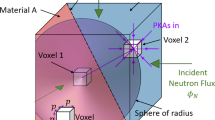Abstract
Recent improvements in computer technology and the interatomic potentials used to describe atomic systems have broadly advanced the state of the art in displacement cascade simulation using the method of molecular dynamics. Molecular dynamics simulations involving more than one million atoms have been carried out in order to study cascades that were initiated at energies up to 40 ke V. The results of these simulations are discussed in the context of their impact on the understanding of the microstructural evolution and mechanical property changes that ensue.
Similar content being viewed by others
References
F.A. Garner, “Overview of the Swelling Behavior of 316 Stainless Steel,” Optimizing Materials for Nuclear Applications, ed. F.A. Garner, D.S. Gelles, and F.W. Wiffen (Warrendale, PA: TMS, 1984), pp. 1l1–141.
J.A. Wang, F.B.K. Kam, and F.W. Stallman, “The Embrittlement Data Base (EDB) and Its Applications,” Effects of Radiation on Materials, ASTMSTP 1270, ed. D.S. Gelles et al. (Philadelphia, PA: ASTM, 1996), pp. 500–521.
R.E. Stoller, “Pressure Vessel Embrittlement Predictions Based on a Composite Model of Copper Precipitation and Point Defect Clustering,” Effects of Radiation on Materials, ASTM STP 1270, ed. D.S. Gelles et al. (Philadelphia, PA: ASTM, 1996), pp. 25–58.
For an example, see the proceedings of the bienniel international Symposia on the Effects of Radiation on Materials, published in a series of special technical publications by the ASTM, Philadelphia. The most recent in this series are STP 1046 (1989), STP l125 (1992), STP l175 (1993), and STP 1270 (1996).
W.J. Phythian et al., J. Nucl. Mater., 223 (1995), pp. 245–261.
R.E. Stoller, “Molecular Dynamics Simulations of High Energy Cascades in Iron,” Microstructure of Irradiated Materials, ed. I.M. Robertson et al. (Pittsburgh, PA: MRS, 1995), pp. 21–26; and R.E. Stoller, Oak Ridge National Laboratory, unpublished research.
J.A. Brinkman, J. Appl. Phys., 25 (1954), pp. 961–969.
A.F. Tasch, Nucl. Inst. and Meth. in Physics Research, B74 (1993), pp. 3–6.
M.-A. Nicolet and S.T. Picraux, eds., Ion Mixing and Surface Layer Alloying (Park Ridge, NJ: Noyes Publications, 1984).
M.J. Norgett, M.T. Robinson, and I.M. Torrens, Nucl. Eng. and Des., 33 (1975), pp. 50–54; see also M.J. Norgett, M.T. Robinson, and I.M. Torrens “ASTME693, Standard Practice for Characterizing Neutron Exposures in Ferritic Steels in Terms of Displacements per Atom (dpa),” Annual Bookof ASTM Standards, vol. 12.02 (Philadelphia, PA: ASTM, 1996).
“ASTM E521, Standard Practice for Neutron Radiation Damage Simulation by Charged-Particle Irradiation,” Annual Book of ASTM Standards, vol. 12.02 (Philadelphia, PA: ASTM,1996).
L.A. Beaven, R.M. Scanlan, and D.N. Seidman, The Defect Structure of Depleted Zones in Irradiated Tungsten, U.S. AEC report NYO-3504-50, Cornell University, Ithaca, NY (1971).
C.A. English and M.L. Jenkins, Mater. Sci. Forum, 15-18 (1987), pp. 1003–1022.
M.L. Jenkins, M.A. Kirk and W.J. Phythian, J. Nucl. Mater., 205 (1993), pp. 16–30.
M.A. Kirk, “Production of Defects in Metals by Collision Cascades: TEM Experiments,” Microstructure of Irradiated Materials, ed. I.M. Robertson et al. (Pittsburgh, PA: MRS, 1995), pp. 47–56.
J.B. Gibson et al., Phys. Rev., 120 (1960), p. 1229.
J.R. Beeler, Jr., “Computer Simulation of Radiation-Induced Void Nucleation and Growth in Metals,” Radiation-Induced Voids in Metals, U.S. AEC CONF-710601 (1972), pp. 684–738.
A.J.E. Foreman, C.A. English, and W.J. Phythian, Phil. Mag., A66 (1992), pp. 655–669.
T. Diaz de la Rubia and M.W. Guinan, Mater. Sci. Forum, 97-99 (1992), pp. 23–42.
R.S. Averback, J. Nucl. Mater., 216 (1994), pp. 49–62.
J.B. Adams et al., J. Nucl. Mater., 216 (1994), pp. 265–274.
I.M. Torrens and M.T. Robinson, “Computer Simulation of Atomic Displacement Cascades in Metals,” Radiation-Induced Voids in Metals, U.S. AEC CONF-710601 (1972), pp. 739–756.
M.T. Robinson, J. Nucl. Mater., 216 (1994), pp. 1–28.
M.Q. Finnis and J.E. Sinclair, Phil. Mag., A50 (1984), pp. 45–55; and M.Q. Finnis and J.E. Sinclair Erratum, Phil. Mag., A53 (1986), p. 161.
A.F. Calder and D.J. Bacon, J. Nucl. Mat., 207 (1993), pp. 25–45.
M.W. Finnis, “MOLDY6—A Molecular Dynamics Program for Simulation of Pure Metals,” AERE R-13182, U.K.AE.A. Harwell Laboratory (1988).
D.J. Bacon et al., Nucl. Instr. and Meth. in Physics Research, B102 (1995), pp. 37–46.
Author information
Authors and Affiliations
Rights and permissions
About this article
Cite this article
Stoller, R.E. Primary damage formation in irradiated materials. JOM 48, 23–27 (1996). https://doi.org/10.1007/BF03223261
Issue Date:
DOI: https://doi.org/10.1007/BF03223261




